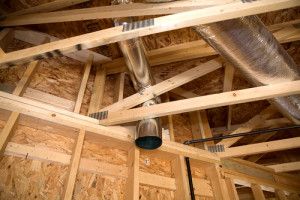 Sometimes what you don’t see can have an enormous impact on your daily life. Proper ductwork design in your Gary area home may not seem important, but many of your home’s quality-of-life issues are affected by the ducts in your heating, ventilation and air conditioning (HVAC) system.
Sometimes what you don’t see can have an enormous impact on your daily life. Proper ductwork design in your Gary area home may not seem important, but many of your home’s quality-of-life issues are affected by the ducts in your heating, ventilation and air conditioning (HVAC) system.
Why Ducts Matter
The ductwork through which heated air moves is also used by the central air conditioner to provide cooled air in summer. Proper sizing, location and installation of ductwork will give your family a correctly humidified, balanced home in which to live and play. Bad duct design can make your home time miserable.
The Secret to Good Ductwork Design
If you’re planning a new Gary area home, the time to consider ductwork is while everything is still on paper. Involve a qualified mechanical contractor to work with your architect and general contractor so ductwork is an integral part and not an afterthought of the overall plan. If you’re planning an addition or remodeling, the same advice applies: get a mechanical contractor in early to make sure the job is done right.
Careful Steps
A qualified contractor will use the Air Conditioning Contractors of America (ACCA) Manuals J, S and D to ensure efficiency and comfort in your Gary home. Manual J gives accurate heating and cooling load calculations, room by room. There can be no guesswork. Everything is compiled in a computer spreadsheet so the correct equipment can be selected. What do we mean by everything? How about room direction, number of windows, anticipated window treatments, expected room use, expected number of occupants, landscaping, prevailing winds and local climate.
Once the heating and cooling loads are correctly calculated, sizing and types of equipment are determined with Manual S. Indiana’s changeable weather makes this step vital for a successful new home or addition.
Clear Choices
At this stage, you and your contractor should consider the pros and cons of various optional features available for your HVAC equipment. While many will make your home more pleasant, only you and your family can determine if they’re right for you:
- Thick media filter
- HEPA filtration
- Electronic air cleaner
- Whole-house humidifier
- Programmable thermostat
- Electrostatic filter
- Chimney liner
- UV germicidal light
After the equipment has been sized and selected, the mechanical contractor turns to Manual D for ductwork design. Air distribution is laid out, taking into account the air handling equipment, register sizes and locations, airflows at those registers, and exact measurements for duct lengths and sizes. Manual D is the only reliable way to calculate duct cross-sections.
Ductwork Design Issues
A common mistake at this stage is to calculate the main ductwork and leave the branch ducts to the installer’s discretion. This is an expensive error which the homeowner pays for it throughout the life of the home. Installers may want to save crew time and equipment costs by using six-inch flexible ducts for branches, without regard to proper airflow.
Suddenly when your house is complete, walls sealed and the furnace kicks on, that tiny half bath in the front hallway roasts anyone inside, while the family room is always chilly. Every duct—main and branch—must be calculated and installed according to Manual D.
Make sure the HVAC installer uses mastic at every duct connection, including at registers and vents. If you see a duct installer picking up duct tape, be concerned. Mastic seals against expensive air leaks and doesn’t wear out in a few years the way tape will. Make sure these terminal ends of the ducts are securely fastened to house structure, so they can’t vibrate during furnace or air conditioner start-up.
Benefits
Why all this attention to tiny ductwork design details no one will ever see? Those ducts behind your Gary home’s walls will be providing plenty of warmth and comfort for years to come. If the ductwork design is poor or installation is shoddy, you’ll hear the ducts rattle, feel cold spots in unexpected places and suffer from unbalanced temperatures.
On the other hand, good ductwork design offers these benefits:
- HVAC equipment runs quietly and efficiently.
- Dust buildup in ducts is minimal.
- Annual maintenance and inspection runs smoothly.
- Airflow is optimal.
- Indoor pollutants are eradicated.
- Your family’s health is protected.
- HVAC equipment lasts longer.
Good ductwork design pays off year after year with lower energy bills and a happy, healthy family. For more help in achieving good ductwork design when considering an addition for your Gary area home or a brand new build, contact us at Meyer’s.

